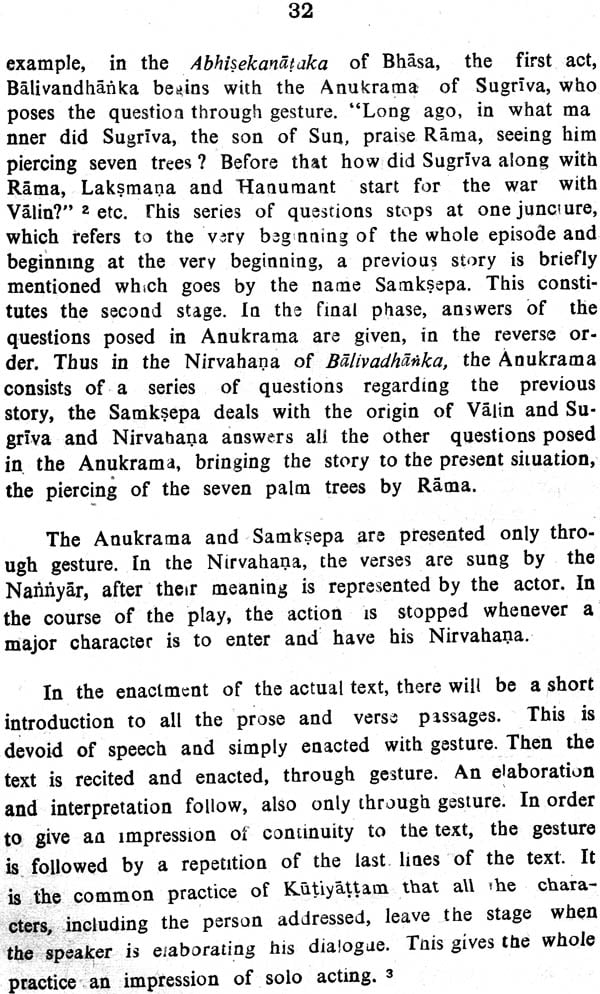
THE TRADITIONAL SANSKRIT THEATRE OF KERALA (Calicut University Sanskrit Series No. 3)
Book Specification
| Item Code: | IDF710 |
| Author: | Dr. C. Rajendran |
| Publisher: | Department of Sanskrit, University of Calicut |
| Language: | English |
| Edition: | 1989 |
| Pages: | 45 |
| Cover: | Paperback |
| wright of the book is 50 gm | |
| Other Details | 7.9" X 5.4" |
| Weight | 50 gm |
Book Description
It is with great pleasure that the Department of Sanskrit is publishing this monograph, The Traditional Sanskrit Theatre of Kerala by Dr. C. Rajendran, Reader jn this Department This is the third book in the 'Calicut University Sanskrit Series' . The other books already published in this serie are The Catalogue of Manuscripts edited by myself and Mimamsa Contribution to Language Studies by Dr. K Kunjunni Raja.
The present work of Dr. Rajendran is an attempt to study Kutiyattam, the traditional Sanskrit theatre of Kerala, in the light of Natyasastra, the earlist authentic text, which deals with the theatrical practices of Sanskrit Drama in all it ramifications. Kutiyattam is the only surviving Sanskrit theatre .in India, which has developed numerous regional features it its course of development. The study of Kl1nyaHam in the background of Nfi!yasfistra will be greatly rewarding in twe respects. Firstly many principles of performance. Described in the Natyasastra, which are unintelligible to the modern readers will cease to be so if viewed from the perspective of a living stage. Secondly, most of the later modifications which have crept into the Kutiyattam theatre could be identi fied on the basis of Natyasastra. Dr. Rajendran's present study in the lines indicated above,' will be greatly useful for the understanding of Natyasastra and Kutiyattam.
In the present study, Dr. Rajendran has given a detailed account of the actual performance of Sanskrit drama, gathered from diverse sources, in the frrst chapter. The second cha pter is a summary of the principles of performance enume rated in Natyasastra. The next chapter deals with the feature' of the Kutiyattam theatre in a concise manner. The con clusions of the study are given in the final chapter.
It is the author's considered view that objections raised against Kutiyattam by medieval works like Natankusa are against the deviations this art form developed in the course of its evolution, with regard to the traditional Sanskrit thea- tre. Many of such modifications must have occurred at the time of the legendary figure, Tolan.
The impact of the regional theatre in Kutiyattam es- pecially on its costumes, the absence of melody instruments and the vedic intonation in verbal acting are some other noteworthy features brought forth by Dr. Rajendran in his study. Such features suggest the distinct individuality of this art form.
It is hoped that the present study will be useful for students and scholars in the field of ancient Sanskrit theatre.
I wish to use this occasion to express our profound thanks to the University authorities for alloting sufficient funds for publishing this volume. We have planned to pu- blish more books also in this series.
This monograph incorporates the results of the research work undertaken by the present author under the U. G. C Scheme entitled 'The staging of Sanskrit Drama - A study with special reference to Kutiyattam' (1982 - 84). It attempts to investigate the basic features of Kutyaittam, the medieval Sanskrit theatre of Kerala in the light of Natyasastra, the authentic work on Sankrit dramaturgy which . represents the conventions followed in ancient India in the enactment o' Sanskrit drama. The ab ence of a living Sanskrit theatre elsewhere in India makes the study of Kutiyattam amply rewarding in the reconstruction of the traditional theatre.
Kutiyattam itself being a late 'discovery' so far as Indologists outside Kerala are concerned, it is understandable that earlier studies were oriented towards its fundamental affinity with the great tradition. But now the accent has to be shifted to the differences this art has developed in the course of its evolution as a regional theatre. A process of Sifting whatever is relatively new may help us to arrive at the essential features of the traditional theatre of Sanskrit in Kutiyattam. This is the perspective adopted in the present work.
I am greatly indebted to the U. G. C. for the financial assistance given to this project. My thanks are also due to the Director, Adyar Library & Research Centre for provid- ing me with library facilities. I am also deeply indebted to Dr. N. V. P. Unithiri, Head of the Department of Sanskrit for including this monograph in Calicut University Sanskrit Series for publication.
| Foreword | I,ii | |
| Preface | 1 | |
| 1. | The Sanskrit Drama and the Stage 2 | |
| 2. | Performance according to Natyasastra | 16 |
| 3. | Kutiyattam as the Sanskrit Theatre | 29 |
| 4. | Conclusions | 37 |
| 5. | Bibliography | 41 |






